
The Cassini-Huygens Mission to Saturn and its Moons
On January 15th 2005, after a seven-year journey, the Huygens probe successfully descended through the atmosphere of and landed on Titan, Saturn’s largest moon.
Titan is the largest moon of Saturn, and the second largest in the Solar System.
Titan
Titan is the second-largest moon in the entire solar system (Jupiter's Ganymede
is slightly larger). It's
bigger than two plantes, Mercury and Pluto.
Orbiting Saturn far from the Sun, its surface temperature is only -180oC
(-292oF). And it's the only moon with a dense atmosphere -- so dense,
in fact, that Titan's near-surface atmospheric pressure is about 60 percent
greater than Earth's. That's about what a scuba diver feels under 20 feet of
water.
Titan orbits Saturn at a distance of about 1.2 million kilometers (745,000 miles), taking about 16 days to complete a full orbit -- 15.94 days to be exact.
Titan is of great interest to scientists because it is the only moon in the solar system known to have clouds and a mysterious, thick, planet-like atmosphere. Scientists have tried for decades to penetrate that thick haze with a variety of telescopes, but got only vague hints at the shape of the surface below.
That changed in 2004 when the Cassini spacecraft's powerful instruments were aimed at the mysterious moon from close range. Cassini's radar instruments are revealing a complex geological surface with very few craters - a sign the surface may be relatively young.
Even with the improved view, Titan remains mysterious. It is still unclear how much of the surface is liquid and how much is solid. There may be lakes, ridges and channels.
During dozens of flybys, the Cassini orbiter will continue to map Titan with cloud-penetrating radar and to collect atmospheric data. In January 2005, the European Space Agency's Huygens Probe dove through Titan's dense atmosphere with instruments capable of analyzing its components.
Combined with the big picture information that that the orbiter Cassini will collect during Titan flybys, data from the Huygens Probe will provide scientists with critical information that may shed light on ancient questions, such as how the planets formed and the evolution of our solar system.
Because of the extremely cold temperatures typical of celestial bodies that are that far away from the sun, the structure of Titan's chemical atmosphere is in a state of deep freeze.
It is this chemical composition that interests scientists a great deal because Titan's atmosphere might consist of compounds similar to those present in the primordial days of the Earth's atmosphere. Titan's thick cloudy atmosphere is mostly nitrogen, like Earth's, but may contain much higher percentages of "smog-like" chemicals such as methane and ethane. The smog may be so thick that it actually rains "gasoline-like" liquids. The organic nature of some of the chemicals found in Titan's atmosphere might indicate that this fascinating moon could harbor some form of life.

| Titan | Earth | |
| Discovered by | Christiaan Huygens | |
| Year of Discovery | 1655 | |
| Orbit (mean distance from Saturn) | 1 221 850 km | |
| Orbital eccentricity | 0.0292 | |
| Orbital inclination | 0.33° | |
| Equatorial Diameter | 5150 km | 12756 km |
| Mass | 1.345 x 1023 kg | 59.7 x 1023 kg |
| Mean Density (water = 1000) | 1881 kgm-3 | ~5000 kgm-3 |
| Rotational Period | 15 days 22 hours | |
| Orbital Period | 15 days 22 hours |
Visibile light cannot escape from the veil of orange smog that covers Titan's
surface. The moon's dry cold atmosphere causes a 300 km thick layer of smog to
build up. The smog, just like on Earth, forms when sunlight interacts with
hydrocarbon molecules.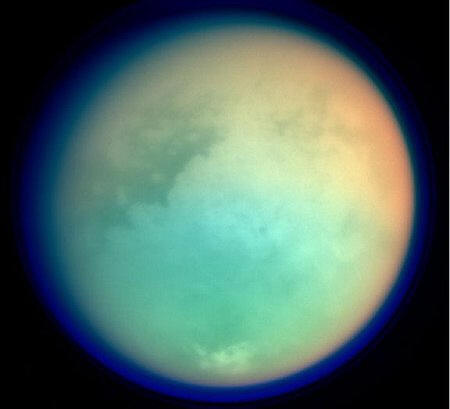
| Molecule | Symbol |
Amount |
| Major Constituents |
Percent |
|
| Nitrogen | N2 |
87-99 |
| Argon | Ar |
0-6 |
| Methane | CH4 |
1-6 |
| Minor Constituents | parts per million | |
| Hydrogen | H2 |
2000 |
| Hydrocarbons | ||
|
Ethane |
C2H6 |
20 |
|
Acetylene |
C2H2 |
4 |
|
Ethylene |
C2H4 |
1 |
|
Propane |
C3H8 |
1 |
|
Methylacetylene |
C3H4 |
0.03 |
|
Diacetylene |
C4H2 |
0.02 |
| Nitrogen Compounds | ||
|
Hydrogen Cyanide |
HCN |
1 |
|
Cynaogen |
C2N2 |
0.02 |
|
Cyanoacetylene |
HC3N |
0.03 |
|
Acteonitrile |
CH3CN |
0.003 |
| Oxygen Compounds | ||
|
Carbon Monoxide |
CO |
50 |
|
Carbon Dioxide |
CO2 |
0.01 |
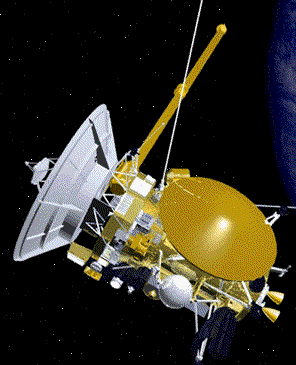
The Cassini-Huygens spacecraft is one of the largest, heaviest and most complex interplanetary spacecraft ever built. The main body of the orbiter is a nearly cylindrical stack consisting of a lower equipment module, a propulsion module and an upper equipment module, and is topped by the fixed, four-meter diameter high-gain antenna. Attached about halfway up the stack are a remote sensing pallet, which carries cameras and other remote sensing instruments, and a fields and particles pallet, which carries instruments that study magnetic fields and charged particles. The two pallets carry most of the Cassini orbiter's science instruments. In general, the entire spacecraft must be turned to orient the instruments in the correct observing direction, although three of the instruments possess their own single-axis articulation capability.
|
Cassini Characteristics |
||
| Dry mass (orbiter only) |
2125 kg |
|
| Launch mass (orbiter, Huygens descent probe, launch vehicle adapter, fuel) |
5712 kg |
|
| Height |
6.7 m
|
|
| Width |
4 m
|
|
| Power (beginning of mission) |
885 W
|
|
| Power (end of nominal mission) |
633 W |
|
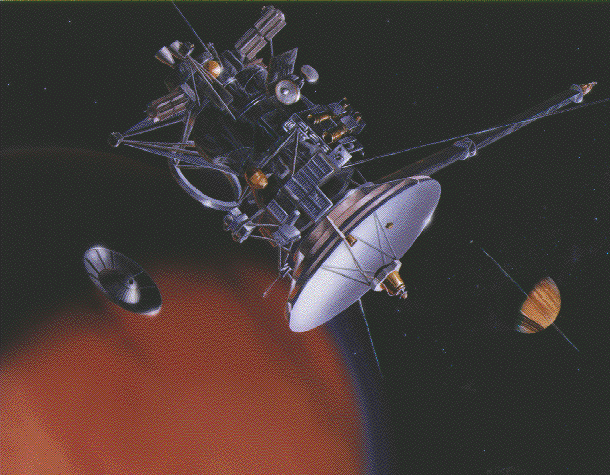 Huygens separated from Cassini on Dec. 24 and began floating around Titan, with its actual descent beginning early
in the morning of January 15th 2005.
Preliminary reports suggest that the probe took 147 minutes to descend through
Titan's hazy atmosphere before it landed on the surface, said Jean-Pierre Lebreton, Huygens mission manager with the European Space Agency (ESA). All
three parachutes appear to have deployed correctly and the descent only took a
few minutes longer than expected.
Huygens separated from Cassini on Dec. 24 and began floating around Titan, with its actual descent beginning early
in the morning of January 15th 2005.
Preliminary reports suggest that the probe took 147 minutes to descend through
Titan's hazy atmosphere before it landed on the surface, said Jean-Pierre Lebreton, Huygens mission manager with the European Space Agency (ESA). All
three parachutes appear to have deployed correctly and the descent only took a
few minutes longer than expected.
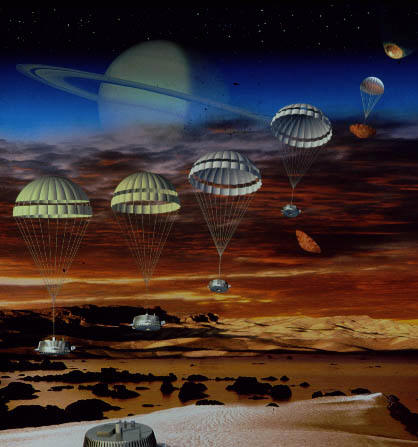
About four minutes into its descent, the probe began transmitting data to Cassini, which then relayed it to Earth with a 67-minute delay. The probe continued to transmit data after landing — extending the probe's expected lifetime — which was a pleasant surprise for the scientists. Huygens was designed to capture images and data from Titan's atmosphere. Scientists had not expected any contact after landing. Part of the reason Huygens may have survived on Titan longer than expected may be that the probe is encased in a thermal outer-layer that keeps the probe itself at about 25 degrees Celsius, Lebreton said. Huygen's batteries could last up to seven hours after landing, Lebreton said, but Cassini will only be able to capture data from the probe for about 30 minutes before it will lose connection.
This is an artist's rendition of the landing, which scientists speculate occurred on land rather than liquid.
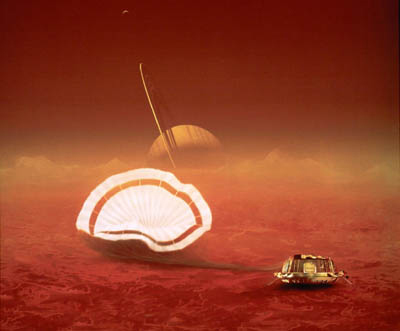 The fact that the probe continued transmitting data after landing could mean
that it landed on land, rather than in liquid, Lebreton said, but it is really
too early to tell. Data and images of Titan's atmosphere or surface are just
starting to reach scientists on Earth. They expect much more data and many more
images later today and throughout the coming days and weeks.
The fact that the probe continued transmitting data after landing could mean
that it landed on land, rather than in liquid, Lebreton said, but it is really
too early to tell. Data and images of Titan's atmosphere or surface are just
starting to reach scientists on Earth. They expect much more data and many more
images later today and throughout the coming days and weeks.
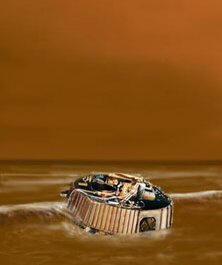
One of the primary reasons for exploring Titan is that its atmosphere and surface are suspected to be most similar to early Earth's and will hopefully help scientists understand what ancient Earth may have looked like.
The First Pictures !!!!!!!!!!!!!!!!!!!!!!!
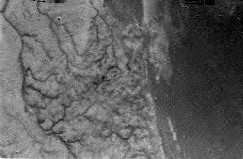 14 January 2005
14 January 2005
This is one of the first raw images returned by the ESA Huygens probe during its
successful descent. It was taken from an altitude of 16.2 kilometres with a
resolution of approximately 40 metres per pixel. It apparently shows short,
stubby drainage channels leading to a shoreline.

Another early image returned by the ESA Huygens probe during its
successful descent. It was taken at an altitude of 8 kilometres with a resolution
of 20 metres per pixel. It shows what could be the landing site, with shorelines
and boundaries between raised ground and flooded plains.

15 January 2005
This composite was produced from images returned on 14 January 2005, by ESA's Huygens probe during its successful descent to land on Titan. It shows a
full 360-degree view around Huygens. The left-hand side, behind Huygens, shows a
boundary between light and dark areas. The white streaks seen near this boundary
could be ground 'fog' of methane or ethane vapour, as they were not immediately
visible from higher altitudes. As the probe descended, it drifted over a plateau
(centre of image) and was heading towards its landing site in a dark area
(right). This dark area is possibly a drainage channel which might still contain
liquid material. From the drift of the probe, the wind speed has been estimated
at around 6-7 metres per second. These images were taken from an altitude of
about 8 kilometres with a resolution of about 20 metres per pixel.
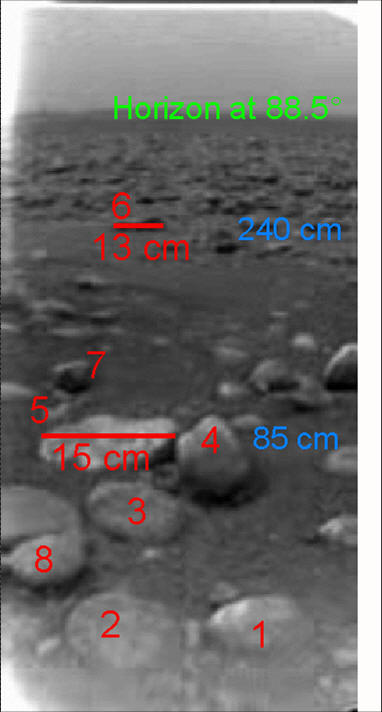
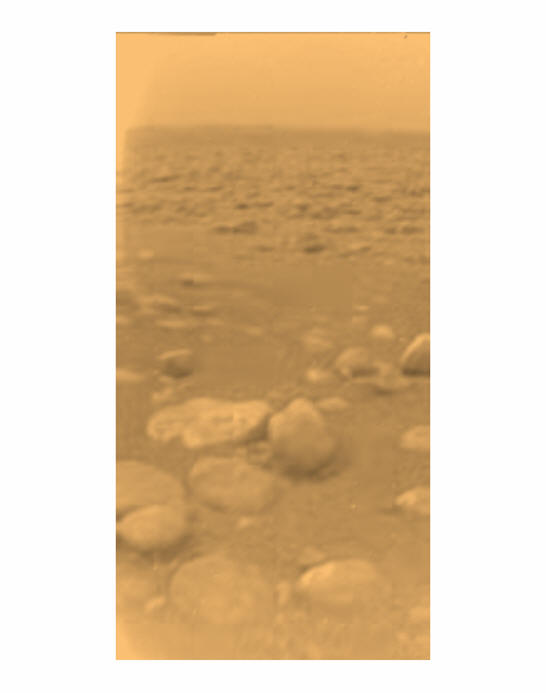
15 January 2005
This raw image was returned yesterday, 14 January 2005, by ESA's Huygens probe
during its successful descent to land on Titan. Sizes have been added to
indicate scale of these features. Initially thought to be rocks or ice blocks,
they are more pebble-sized. The two rock-like objects just below the middle of
the image are about 15 centimetres (left) and 4 centimetres (centre) across
respectively, at a distance of about 85 centimetres from Huygens. The surface is
darker than originally expected, consisting of a mixture of water and
hydrocarbon ice. There is also evidence of erosion at the base of these objects,
indicating possible fluvial activity. The image at right is a coloured view,
processed to add reflection spectra data, gives a better indication of the
actual colour of the surface.
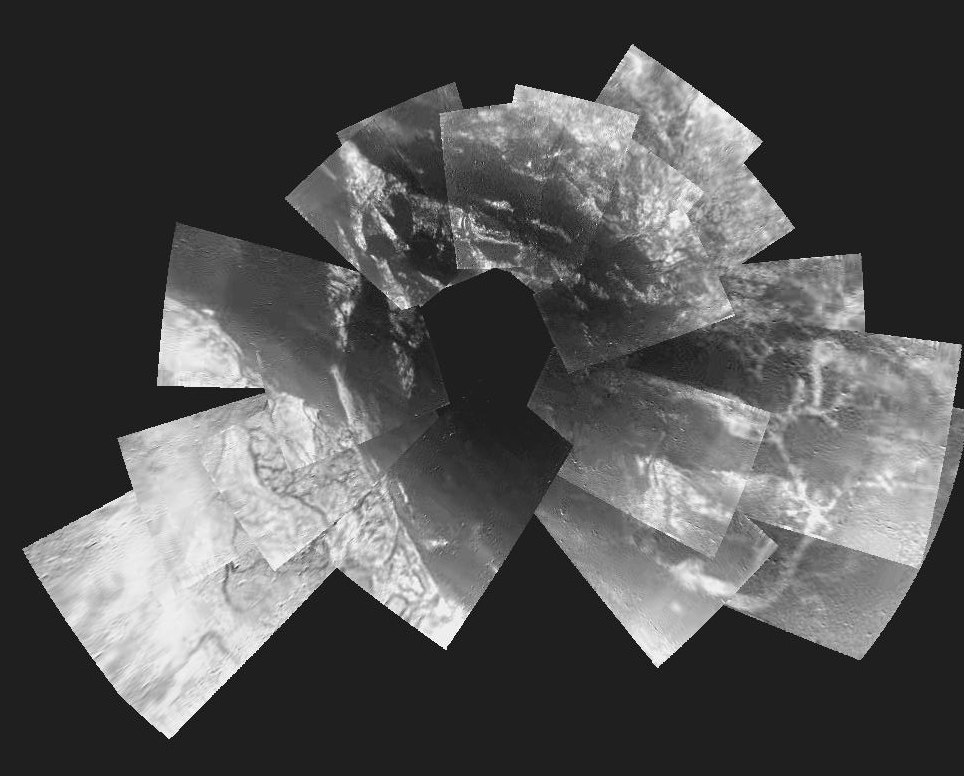
17 January 2005
This picture is a composite of 30 images from ESA's Huygens probe. They were
taken from an altitude varying from 13 kilometres down to 8 kilometres when the
probe was descending towards its landing site. These images were taken
with a resolution of about 20 metres per pixel and cover an area extending out
to 30 kilometres.